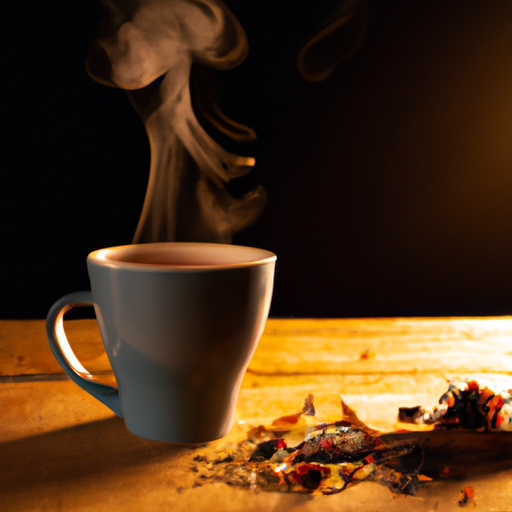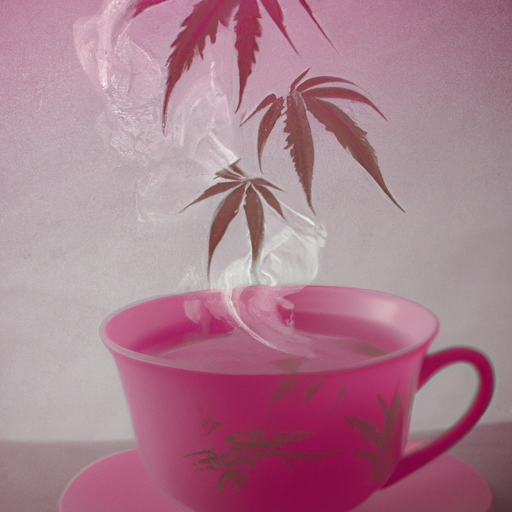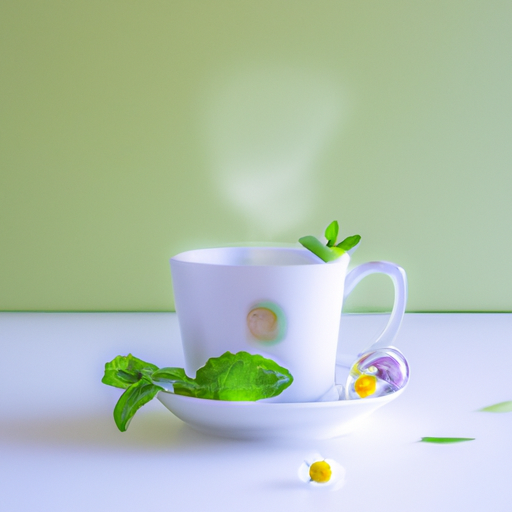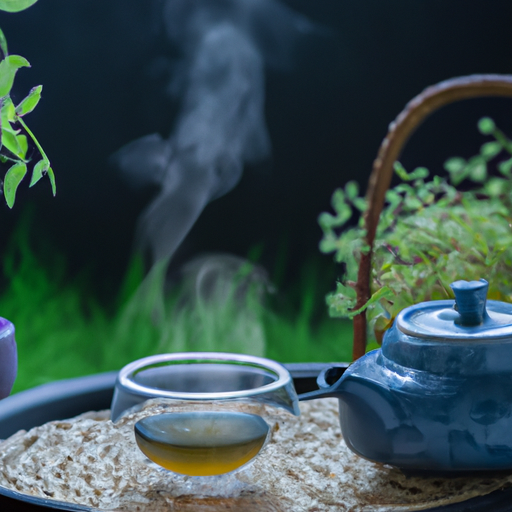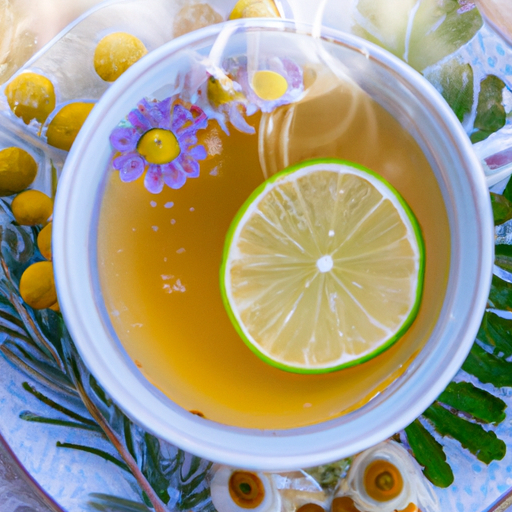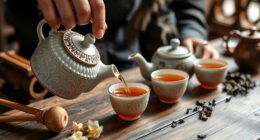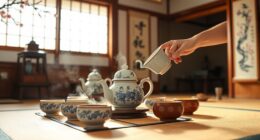Have you ever taken a sip of herbal tea and thought, ‘Hmm, something seems off’? It’s possible that the temperature of your brew was not quite right. As a tea enthusiast, I understand the importance of finding the perfect temperature to enjoy herbal tea at its best.
That’s why I embarked on a personal quest to uncover the ideal temperature for brewing herbal tea.
Let me share with you what I discovered. During my exploration, I found that the temperature of the water has a significant impact on the flavor and aroma of herbal tea. Whether it’s a calming chamomile or a refreshing peppermint, each herb requires a specific temperature range to unleash its full potential.
In this article, I will delve into the factors to consider when brewing herbal tea, the ideal temperature range for different herbs, and how to achieve the right temperature for your brew. I will also discuss the importance of steeping time and temperature, and provide tips for enjoying herbal tea at the perfect temperature.
So, grab your favorite mug and join me on this flavorful journey!
Key Takeaways
- Different herbal teas have different ideal brewing temperatures.
- Experimenting with temperature can unlock different flavor profiles.
- The temperature at which tea is consumed can impact health benefits.
- Personal preference determines the best temperature to drink herbal tea.
Factors to Consider when Brewing Herbal Tea
When brewing herbal tea, it’s important to consider factors such as steeping time, water temperature, and the quality of the tea leaves. Steeping techniques play a crucial role in extracting the full flavor and benefits of herbal teas.
Different herbs require different steeping times, ranging from 5 to 10 minutes. However, the impact of temperature on flavor is equally significant. The ideal temperature range for herbal tea is between 175 and 205 degrees Fahrenheit (80 to 96 degrees Celsius). Brewing at higher temperatures can result in a bitter taste, while lower temperatures may not fully extract the flavors and beneficial compounds.
It’s important to note that delicate herbal teas, like chamomile or hibiscus, are best steeped at lower temperatures, around 175 degrees Fahrenheit (80 degrees Celsius).
As we move forward to discuss the ideal temperature range for herbal tea, it’s crucial to understand how different temperatures affect the taste and overall experience of enjoying this soothing beverage.
The Ideal Temperature Range for Herbal Tea
Indulge yourself in the comforting warmth of properly steeped herbal tea, allowing it to envelop your senses and transport you to a state of pure relaxation. When it comes to brewing herbal tea, the ideal temperature plays a crucial role in extracting the perfect flavor and aroma. Different herbal teas have different temperature requirements, and getting it right can truly enhance your tea-drinking experience.
Temperature has a significant impact on the flavor profile of herbal tea. Brewing at too high a temperature can result in a bitter and astringent taste, while brewing at too low a temperature may leave the tea weak and lacking in flavor. To help you achieve the perfect cup, I’ve created a table below that outlines the ideal brewing temperatures for some popular herbal teas:
| Herbal Tea | Ideal Brewing Temperature |
|---|---|
| Chamomile | 200°F (93°C) |
| Peppermint | 212°F (100°C) |
| Rooibos | 205°F (96°C) |
| Lavender | 190°F (88°C) |
| Hibiscus | 208°F (98°C) |
By following these temperature guidelines, you can unlock the full potential of each herbal tea’s unique flavor profile. In the next section, I will guide you on how to achieve the right temperature without the need for complicated steps.
How to Achieve the Right Temperature
To ensure the perfect infusion, it’s essential to master the art of achieving the right temperature for your favorite herbal brew. Achieving consistency in water temperature is crucial for extracting the full flavor and benefits of herbal tea. One effective method to achieve the ideal temperature is by using a thermometer. Here’s how you can do it:
-
Boil water: Start by bringing water to a rolling boil. This step helps to eliminate any impurities and ensures a clean, fresh taste.
-
Let it cool: Remove the boiling water from heat and let it sit for a few minutes. This allows the temperature to drop slightly, creating a more suitable environment for steeping.
-
Check with a thermometer: Use a thermometer to measure the temperature. Different herbal teas require specific temperatures for optimal flavor. For example, delicate herbal blends like chamomile or lavender usually need water around 175°F (80°C), while robust infusions like peppermint or ginger may require slightly hotter water, around 195°F (90°C).
Achieving the right temperature is just the first step towards a delightful herbal tea experience. Now that you know how to achieve the perfect temperature, let’s explore the importance of steeping time and temperature in the subsequent section.
Steeping Time and Temperature
Mastering the art of steeping is like finding the perfect dance partner for your herbal brew – it’s all about finding the right rhythm and timing. When it comes to steeping herbal tea, the temperature plays a crucial role in unlocking the full flavor profile of the herbs.
Different herbs require different steeping techniques, and the impact of temperature on flavor cannot be underestimated. For delicate herbal teas, such as chamomile or peppermint, a lower temperature of around 175°F (80°C) is recommended. This helps to preserve the delicate flavors and prevent any bitterness.
On the other hand, robust herbal teas like ginger or hibiscus can withstand higher temperatures, around 200°F (93°C), which helps to extract the full-bodied flavors.
Steeping time also plays a role in the flavor development of herbal tea. Generally, a steeping time of 5-7 minutes is sufficient to extract the desired flavors. However, some herbs may require longer steeping times to fully infuse in the hot water.
Now that we understand the importance of steeping time and temperature, we can move on to the next step – experimenting with temperature. By adjusting the temperature slightly higher or lower, you can unlock different flavor profiles and find the perfect balance for your taste buds.
Experimenting with Temperature
Get ready to explore a world of flavor as you play with different temperatures and discover the perfect infusion for your taste buds. When it comes to herbal tea, temperature plays a crucial role in bringing out its unique flavors and aromas.
Through my experiments, I’ve found that different teas require different temperature ranges for optimal taste. For delicate herbal teas like chamomile or lavender, a lower temperature of around 175°F (80°C) is ideal. This allows the delicate flavors to bloom without becoming bitter.
On the other hand, robust herbal teas like peppermint or ginger can withstand higher temperatures of around 200°F (93°C) without losing their potency. Alternative brewing methods can also affect the temperature and ultimately the taste of your herbal tea.
For example, cold brewing herbal tea overnight in the refrigerator can result in a smoother, less bitter flavor profile. Additionally, using a temperature-controlled electric kettle can help ensure precise brewing temperatures.
By experimenting with different temperatures and brewing methods, you can unlock a world of flavors and find the perfect temperature for your favorite herbal teas. So, let’s dive in and discover the joy of sipping herbal tea at its ideal temperature.
Tips for Enjoying Herbal Tea at the Ideal Temperature
When it comes to enjoying herbal tea at the ideal temperature, there are a few tips that I find helpful.
First, using insulated tea mugs or pots can help to maintain the temperature of the tea for a longer period of time. This ensures that I can savor every sip without it getting too cold.
Additionally, adding honey or other flavorings to the tea can enhance the taste and make it even more enjoyable.
Using insulated tea mugs or pots
Sipping from an insulated tea mug feels like embracing a warm hug on a chilly winter day. Insulated tea accessories, such as mugs or pots, are designed to keep your herbal tea at the ideal temperature for a longer period of time.
The use of insulation allows the tea to stay hot, or cold, depending on your preference. These accessories are perfect for those who enjoy savoring their tea slowly, as the temperature control prevents it from becoming lukewarm or losing its flavor. Additionally, insulated mugs and pots are portable, making them convenient to take on the go.
With an insulated tea mug, you can enjoy your favorite herbal blend at the perfect temperature wherever you are. Speaking of flavor, adding honey or other flavorings can enhance the taste of your tea without altering its temperature.
Adding honey or other flavorings
When it comes to enjoying herbal tea, the temperature is not the only factor that can enhance your experience. Another way to elevate the taste is by adding honey or other flavorings. These additions not only bring a delightful sweetness but also introduce an array of flavor combinations that can tantalize your taste buds. Honey, for example, pairs well with chamomile, while mint leaves can be combined with lemon for a refreshing twist. Moreover, certain flavorings like ginger or cinnamon also offer their own unique health benefits. Ginger, for instance, can aid digestion, while cinnamon may help regulate blood sugar levels. By experimenting with different flavor combinations, you can not only create a personalized herbal tea experience but also enjoy the potential health benefits they bring. Moving forward, let’s explore the conclusion and final thoughts on the best temperature and overall enjoyment of herbal tea.
Conclusion and Final Thoughts
To fully immerse yourself in the delightful world of herbal tea, embrace the warmth that caresses your taste buds at the perfect temperature. Finding the best temperature to drink herbal tea can enhance your experience and allow you to fully appreciate its flavors and health benefits.
Here are three key factors to consider:
-
Brewing Techniques:
- Different herbal teas require different brewing techniques. For delicate herbal teas like chamomile or mint, a lower temperature around 175°F (80°C) is ideal. This allows the flavors to infuse gently without becoming bitter.
- Stronger herbal teas like ginger or rooibos can withstand higher temperatures. Brewing them at around 200°F (93°C) helps extract the robust flavors and soothing properties.
-
Health Benefits:
- The temperature at which you drink herbal tea can impact its health benefits. Warm herbal tea can have a calming effect on the body, promoting relaxation and aiding digestion.
- However, avoid drinking herbal tea that’s too hot, as it can potentially harm your throat and esophagus. Aim for a comfortable temperature that allows you to enjoy the tea without risking any harm.
-
Personal Preference:
- Ultimately, the best temperature to drink herbal tea depends on your personal preference. Experiment with different temperatures to find what suits you best. Remember to let the tea cool down a bit before taking your first sip, as scalding hot tea can mask its delicate flavors.
The best temperature to drink herbal tea varies depending on the type of tea, desired health benefits, and personal preference. By understanding these factors and experimenting with different temperatures, you can fully enjoy the delightful world of herbal tea.
Frequently Asked Questions
Can I drink herbal tea at room temperature?
Yes, you can drink herbal tea at room temperature. However, it’s important to note that temperature plays a crucial role in brewing herbal tea and affects its taste. Let’s explore how temperature impacts the flavor of herbal tea.
Does the type of herbal tea affect the ideal temperature to drink it?
The ideal temperature to drink herbal tea varies depending on the type. Steeping time affects flavor, with shorter times producing lighter tastes. Different temperature ranges reveal unique flavor profiles, enhancing the experience of each herbal tea variety.
Can I use a regular tea kettle to achieve the right temperature for herbal tea?
Using a regular tea kettle for herbal tea, temperature plays a crucial role in flavor. It’s important to heat the water to the recommended temperature for each type of herbal tea to enhance its unique flavors and aromas.
Should I adjust the steeping time when experimenting with different temperatures?
When adjusting steeping time, it’s important to consider temperature for optimal taste. As the saying goes, "patience is a virtue." Higher temperatures may require shorter steeping times, while lower temperatures may need longer.
Are there any health benefits associated with drinking herbal tea at the ideal temperature?
Drinking herbal tea at the ideal temperature offers several health benefits. It can aid digestion, boost the immune system, promote relaxation, and provide antioxidant support. Temperature preferences may vary, but finding the right balance is key.
Conclusion
In conclusion, finding the perfect temperature to savor your herbal tea is like uncovering a hidden treasure. Like a skilled navigator, I’ve guided you through the vast seas of brewing techniques, unveiling the ideal temperature range. Armed with this knowledge, you can now embark on a sensory journey, where each sip of herbal tea becomes a symphony of flavors.
Remember, it’s not just about the temperature, but also the steeping time and your personal preferences. So, go forth, my fellow tea connoisseurs, and indulge in the warmth of herbal perfection.

